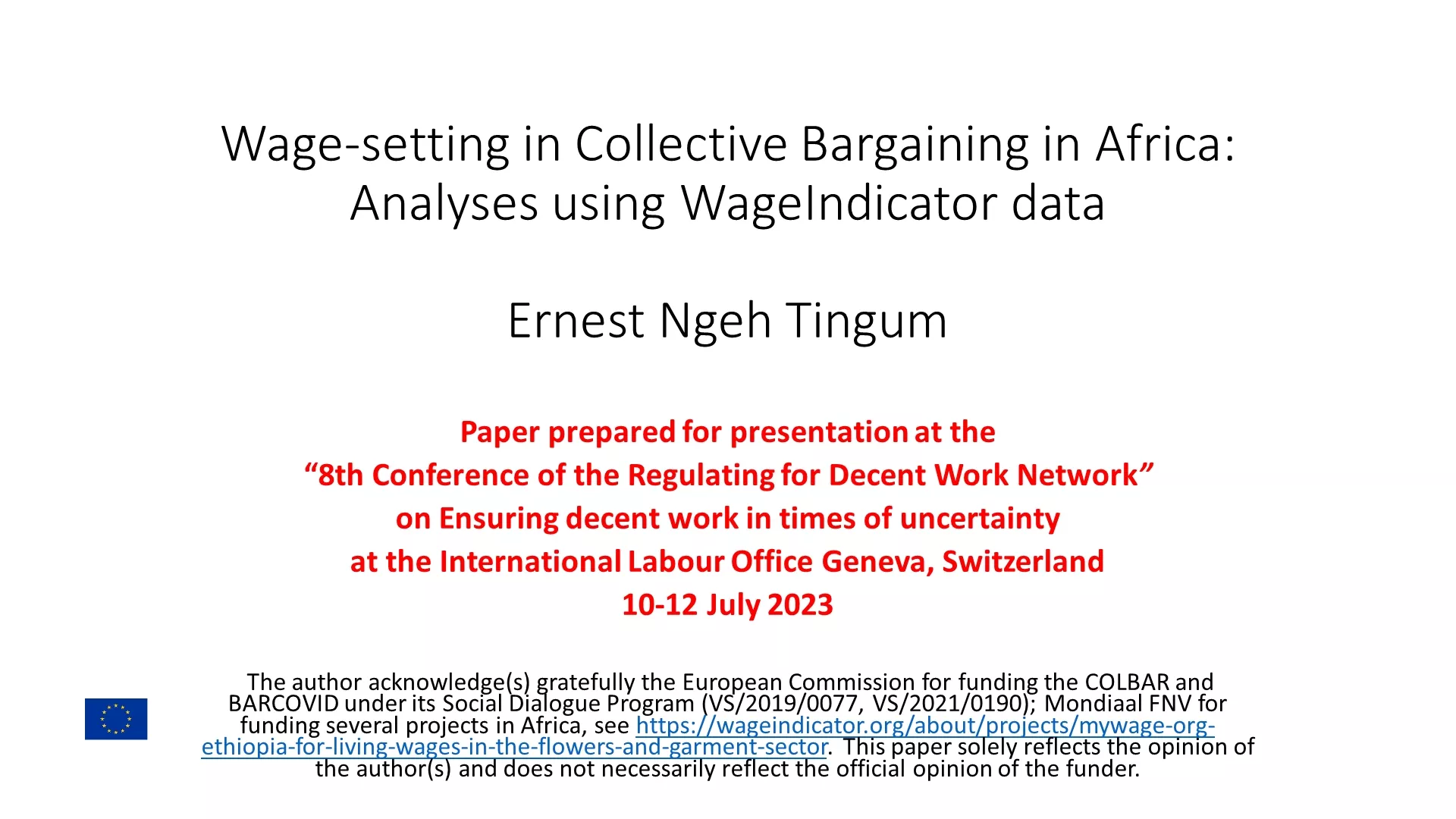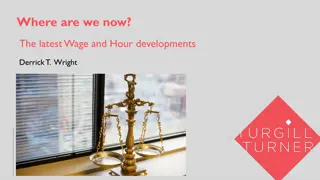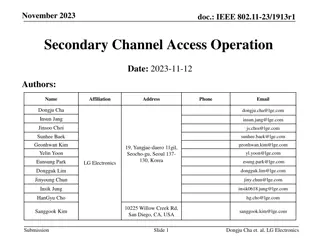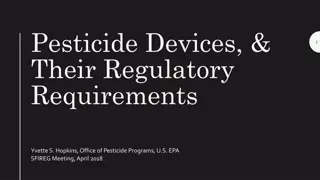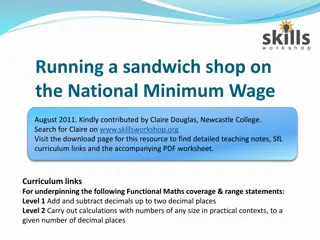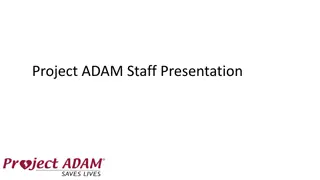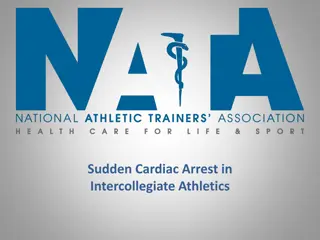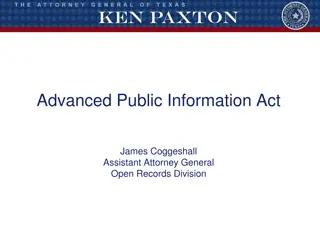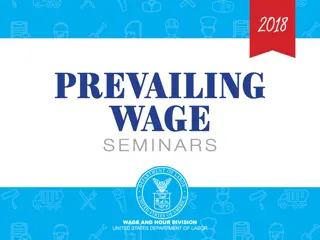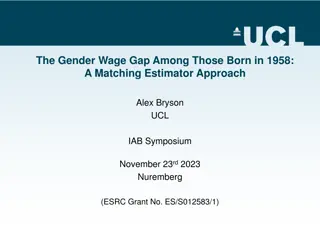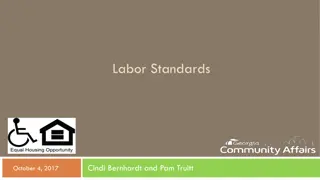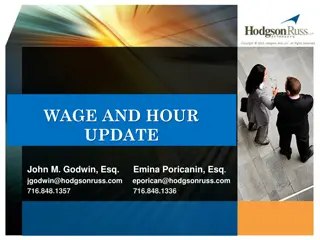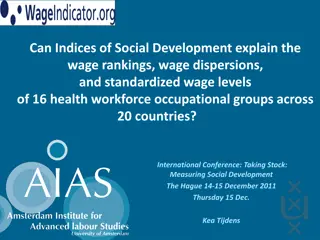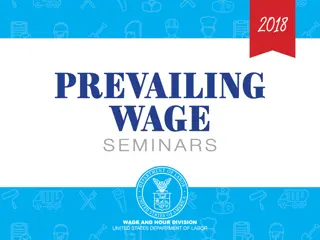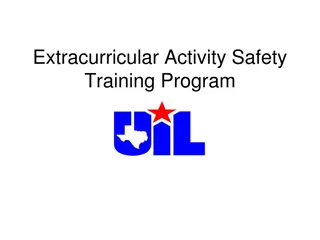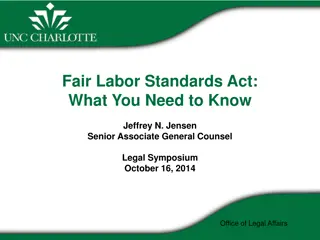SCA Section 4(c) and Wage Determinations
The content delves into the intricacies of Service Contract Act (SCA) Section 4(c) and wage determinations. It covers the statutory requirements, application of Collective Bargaining Agreements (CBA), successor contractor obligations, limitations, exceptions, and more. The key focus is on how Section 4(c) provisions apply to successor contracts, including wage rates, application criteria, and limitations on self-executing applications.
Download Presentation

Please find below an Image/Link to download the presentation.
The content on the website is provided AS IS for your information and personal use only. It may not be sold, licensed, or shared on other websites without obtaining consent from the author.If you encounter any issues during the download, it is possible that the publisher has removed the file from their server.
You are allowed to download the files provided on this website for personal or commercial use, subject to the condition that they are used lawfully. All files are the property of their respective owners.
The content on the website is provided AS IS for your information and personal use only. It may not be sold, licensed, or shared on other websites without obtaining consent from the author.
E N D
Presentation Transcript
SCA Section 4(c) Wage Determinations
Section 4(c) WDS Incumbent CBA Part of 1972 Amendments to SCA. Statutory requirement. Does not depend on issuance of a WD. Short-form WD should be issued. Based on incumbent CBA. Includes accrued, as well as prospective, wages and fringe benefits. A contractor may be its own successor.
Application The CBA must be applicable to work performed on the predecessor contract in order to have application to the successor contract. The successor contract must be for substantially the same services being provided in the same contract locations.
Provisions Successor contractor must pay CBA rates: whether or not predecessor employees are hired; whether or not signatory to the CBA. Obligations of Section 4(c) are self-executing. Interpretation of CBA is based on the intent of the parties signatory to CBA.
Limitations of Section 4(c) Section 4(c) does not extend to other CBA provisions such as: Seniority; Grievance procedures; Work rules; or Overtime.
Limitation on Self-Executing Application of 4(c) Applies if the contracting officer (CO) provides the contractor and union with written notice of key procurement dates: IFB CBA must be received by CO not less than 10 days before bid opening. RFP (Request for Proposal) CBA must be received before award if start is within 30 days; or RFP Not less than10 days before start if award is beyond 30 days.
Exception to the Application of Section 4(c) Requirement The successor contractor is statutorily obligated to pay the CBA rates until such time as the CBA is determined to be: Substantially at variance with locally prevailing rates (29 C.F.R. 4.10); or Not reached as a result of arm s-length negotiations (29 C.F.R. 4.11).
Contract Reconfigurations (29 CFR 4.163 (g)) Section 4(c) provisions will follow identifiable contract work on consolidated or reconfigured contracts in the same locality If more than one predecessor performing the same functions with substantially the same job classifications, the predecessor contract covering the greater percentage of work is deemed to be the predecessor contract for Section 4(c) purposes
Reconfigured Contracts - Award to Contract with Greater Portion of Work in Same Functions ABC Co. Contract 2 Cleaning Class Janitors Number of Workers = 20 Value of Contract = $750,000 WD 4(c) CBA with JWC Union XYZ Co. Contract 1 Cleaning Class Janitors Number of Workers = 15 Value of Contract = $500,000 WD Prevailing
Interruption of Contract Services (29 CFR 4.163(h)) Section 4(c) is not negated because the contracting authority may change and the successor contract is awarded by a different contracting agency Bridge or short-term interim contracts due to bid protest, default by the predecessor contractor, temporary closing of facility, etc., are not predecessor contracts for Section 4(c) purposes as successorship provisions of Section 4(c) apply to full-term successor contracts
Example of 4(c) application FY 15---------- ABC Co. FY 16-------- FY 17-------- XYZ Co. XYZ Co. If ABC Co. performed under a CBA during the FY 15 contract, Section 4(c) requirements would apply to the successor FY 16 contract. If XYZ Co. negotiates a CBA during the FY 16 contract, then a Section 4(c) will apply to the succeeding FY 17 contract
Example II of 4(c) Application II. FY 15-------FY 16-----CY 16------CY 17 ABC Co. DOD XYZ Co. XYZ Co FY 15 - ABC Co. performed under a CBA FY 16 - DOD temporarily suspends contract for renovations. (Short-term interim contract) CY 16 - DOD awards full-term contract to XYZ Co. Section 4(c) WD applies as ABC Co. is the predecessor contractor as it is a full-term contracts CY-17 - If XYZ fails to negotiate a CBA during CY-16, a prevailing WD would apply
Administrative Hearings Regarding Application of Section 4(c) Substantial Variance & Arm s-Length Negotiations
Introduction to Section 4(c) Administrative Hearings There are two types of hearing appeals under the SCA concerning section 4(c) wage determinations: An appeal based on substantial variance issues; or An appeal based on issues concerning arm s-length negotiations.
Introduction to Section 4(c) Administrative Hearings Whenever a section 4(c) wage determination is issued: The successor contractor is required to pay the wage rates and fringe benefits contained in the predecessor contractor s collective bargaining agreement (CBA). These rates are to be paid unless there is found to be a substantial variance between the collectively bargained rates and those prevailing in the locality, and/or the lack of arm s-length negotiations in arriving at the collectively bargained rates. See 29 C.F.R. 4.10 4.11, AAM No. 166 and AAM No. 159.
Substantial Variance Hearings 29 C.F.R. 4.10 A finding that a 4(c) substantial variance exists, at a hearing before an Administrative Law Judge (ALJ), requires that such wage rates and/or fringe benefits in the CBA are found to vary substantially from those that would otherwise prevail for services of a similar character in the locality.
Substantial Variance The SCA does not define the term substantial variance. Plain meaning of the term requires that a considerable disparity in rates exist before the successorship obligation may be avoided. No discrete comparison rate is conclusive. Collectively bargained rates often can be expected to exceed service industry prevailing rates, and where some variance should be the norm, a finding of substantial variance would require a collectively bargained rate clearly to fall out of line when compared to a comprehensive mix of rates.
Substantial Variance Hearings (cont d) A request for a hearing must contain information and analysis concerning the differences between the collectively bargained rates issued and the rates contained in: (a) Corresponding federal wage board rates and surveys. While it is not necessary that the challenged rate be higher than the corresponding federal rate, this is an important factor. (b) Relevant Bureau of Labor Statistics survey data and the comparable SCA area wage determination. (c) Other relevant wage data. For example, rates paid in local hospitals would be appropriate for comparison on contracts for hospital aseptic services, while the rates paid in local schools could be of value in comparison for janitorial or food service workers. (d) Other collectively bargained wages and benefits.
Substantial Variance Hearings (cont d) A request for a hearing is expected to address all relevant issues. However, it is recognized that a petitioner may not be able to submit complete data at the time the hearing request is made. Where efforts to obtain supporting evidence are in progress, information must be provided concerning the approximate time necessary to complete the gathering of additional data. Merely providing a statement that data are not available is not sufficient. The request must adequately demonstrate the effort made to obtain or develop such information.
Substantial Variance Hearings (cont d) The WHD Administrator can grant or deny the substantial variance hearing request. A request is granted only if the review results in a determination that a substantial variance may exist. The WHD must respond to the request within 30 days of receipt. If a substantial variance is found to exist, a new wage determination must be issued which reflects prevailing rates for the locality rather than those found in the predecessor contractor s CBA. The collectively bargained rates in the 4(c) wage determination apply until a final decision from the ALJ or ARB.
Arms-Length Negotiations 29 C.F.R. 4.11 and AAM No. 159 To have effect under section 4(c), the wages and fringe benefits provided in the predecessor s CBA must be reached as a result of arm s-length negotiations. This precludes arrangements by parties to a CBA who either separately or together, act with an intent to take advantage of the wage determination process. In short, it addresses the Sweetheart Agreement, between contractor and union, which includes making a CBA contingent upon the issuance of a supporting wage determination requiring reimbursement of the contractor by the funding agency.
SCA Determinations Concerning Arm s-Length Negotiations The determination as to whether the CBA has application for section 4(c) purposes must be made pursuant to the SCA and its implementing regulations by the WHD, not by the contracting agency. As a result of a section 4(c) arm s-length hearing, investigation or otherwise pursuant to the SCA, if it is found that the CBA itself or any of the wage rates or fringe benefits contained therein were not established through arm s-length negotiations, the CBA wage rates and fringe benefits cannot be issued for wage determination purposes. If a lack of arm s-length negotiations is found to exist, a new wage determination must be issued that reflects the prevailing rates for the locality rather than those found in the predecessor contractor s CBA.
Two-step Process to Address Arm s-Length Negotiations Issues For arm s-length negotiations issues a two- step process may be needed. The WHD Administrator must first issue findings before a hearing can be initiated. Such findings may result in the Administrator s referral of the case to an ALJ or ARB hearing. If the Administrator s determination does not include referral of the case for a hearing, an interested party may then request a hearing.
Section 4(c) Administrative Hearings Request Procedures & Time Frames Substantial Variance Hearing and Arm s-Length Determination Requests Either request can be submitted by any affected interested party: including, but not limited to, contracting agencies, incumbent contractors, prospective contractors, contractor and employer associations, employees or their representatives, or other interested government agencies. The interested party submits a written request for the substantial variance hearing or arm s-length determination to the WHD Administrator. The request must contain information as specified in the regulations at 29 C.F.R. 4.10(b)(1)(i) for substantial variance proceedings, and at 29 C.F.R. 4.11(b)(1) for arm s-length determinations, including the following information: (see next slides)
The number of all wage determinations at issue, name of the contracting agency involved, and a brief description of the services to be performed under the contract ( substantial variance request only). A statement regarding the status of the procurement and any estimated procurement dates, such as bid opening, contract award, or commencement date of the contract or its follow-up option period. That the applicable CBA wage rates and fringe benefits contained therein were not reached as a result of arm s-length negotiations, or that the CBA rates substantially vary from those prevailing in the locality. (Continues next slide)
(Note: Supportive evidence such as data concerning wages and/or fringe benefits prevailing in the locality or information concerning arm s-length negotiations should be included. If the only information submitted concerning a substantial variance of fringe benefits is an SCA wage determination, it is insufficient, and the party requesting the hearing will be so advised.) Names and addresses (to the extent known) of any interested parties. (Continues next slide)
For either type of request, information must be submitted as follows (according to 29 C.F.R. 4.10(b)(3) for substantial variance hearing requests; and 29 C.F.R. 4.11(b)(2) for arm s- length determinations): Prior to 10 days before contract award of an advertised contract; or Prior to the contract or option period start date, if a negotiated contract, or existing contract with an option extension period.
Section 4(c) Administrative Hearings Section 4(c) Administrative Hearings Request Procedures & Time Frames Request Procedures & Time Frames Administrator s Arm s Administrator s Arm s- -Length Ruling Length Ruling The WHD Administrator, on his or her own motion or after receipt of a request for a determination, may make a finding on the issue of arm s-length negotiations. For arm s-length determination requests, the WHD Administrator issues findings as to whether the wages and fringe benefits at issue were reached as a result of arm s-length negotiations or that such negotiations did not take place, or a finding that there is insufficient evidence to make a determination, and the Administrator may refer the case to an ALJ hearing.
Section 4(c) Administrative Hearings Request Procedures & Time Frames Administrator s Arm s-Length Ruling (cont d) If the Administrator determines that there may not have been arm s-length negotiations, but finds that there is insufficient evidence to render a final decision, the Administrator may refer the case to an ALJ hearing. The regulations do not state a required response time frame for the Administrator s decision.
Section 4(c) Administrative Hearings Request Procedures & Time Frames Arm s-Length Hearing Requests For those cases not referred by the WHD Administrator for a hearing before an ALJ, any interested party may subsequently request a hearing, as follows: Submit a written request for a hearing to the Administrator within 20 days of the Administrator s ruling. Include in the request a detailed statement of the following: Reasons why the Administrator s finding is incorrect. Facts alleged to be disputed.
Section 4(c) Administrative Hearings Request Procedures & Time Frames Arm s-Length Hearing Requests If no hearing is requested within the time limit, the Administrator s ruling stands. If an arm s-length hearing is requested, the Administrator refers the request: If the Administrator finds facts to be in dispute, to the Chief ALJ for designation of an ALJ to conduct a hearing; or To the ARB if the Administrator determines that no material facts are in dispute.
Section 4(c) Administrative Hearings Request Procedures & Time Frames ALJ Hearing Granted Once a hearing is granted by the Administrator, an Order of Reference with supporting documentation attached is submitted by the Administrator to the Chief ALJ and served on all interested parties. Hearings are conducted by a designated ALJ in accordance with procedures outlined in 29 C.F.R. Part 6. Within 20 days of the Order of Reference mailing date as indicated by the Certificate of Service, interested parties wishing to participate in the hearing must submit a hearing response to the Chief ALJ. The Chief ALJ appoints an ALJ to hear the case who will then notify all interested parties of the time and place for the prehearing conference and subsequent hearing. These must be scheduled within 60 days from the mailing date of the Order of Reference.
Appeal to the Administrative Review Board An appeal of an ALJ decision may be submitted to the ARB pursuant to the procedures in 29 C.F.R. Part 8: Practice before the Administrative Review Board with regard to Federal Service Contracts. Where material facts are not in dispute, the request shall be referred to the ARB. Substantial variance or arm s-length hearing requests denied by the WHD Administrator, where material facts are in dispute, shall be referred to the Chief ALJ.
Disclaimer This presentation is intended as general information only and does not carry the force of legal opinion. The Department of Labor is providing this information as a public service. This information and related materials are presented to give the public access to information on Department of Labor programs. You should be aware that, while we try to keep the information timely and accurate, there will often be a delay between official publications of the materials and the modification of these pages. Therefore, we make no express or implied guarantees. The Federal Register and the Code of Federal Regulations remain the official source for regulatory information published by the Department of Labor. We will make every effort to keep this information current and to correct errors brought to our attention.


